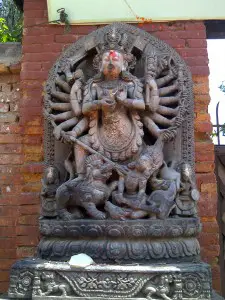 Much of Nepal’s history is shrouded in myth. The early history of Nepal began in the Kathmandu Valley, which was once a lake that drained about 200,000 years ago. Geologists haven’t found the cause yet, but legends say that the god Manjushri made a narrow gorge in the valley wall and drained the water.
Much of Nepal’s history is shrouded in myth. The early history of Nepal began in the Kathmandu Valley, which was once a lake that drained about 200,000 years ago. Geologists haven’t found the cause yet, but legends say that the god Manjushri made a narrow gorge in the valley wall and drained the water.
In the 7th and 8th century, the Hindu god Indra, disguised as human, is said to have visited the valley (to meet the king).
About 563 BC, Siddharta Gautama, the founder of Buddhism, was born in Lumbini, a town located in the southern plains of Nepal. During his travels, it is believed he also visited Kathmandu.
Around 300 AD, by the time of the Licchavi Dynasty, Nepal reached its first golden age. By now, Hinduism and Buddhism were firmly established.
610s – One of the most significant legacies of Nepal is its introduction of Buddhism to Tibet via Bhirkhuti, a Nepalese woman, who was given in marriage to the Tibetan king Tsrong Gompo, the founder of the Tibetan Empire. Bhirkhuti is worshiped in Tibet as Green Tara, a symbol of mercy and compassion. Nepali Buddhists also worship her.
In 733, the last Licchavi king died and Nepal enters its dark age.
In 1200, the Malla Dynasty was established. Although the Malla kings were Hindu, they established a peaceful coexistance with the Buddhists.
In 1364, Muslims from Bengal take over the valley for a short period of time.
In the 15th century, the second golden age of Nepal begun under the Mallas. Kathmandu, Bhaktapur and Patan were established as the valley’s three main cities and centers of commerce with India and Tibet. Later on, they became three independent kingdoms.
In 1768, Prithvi Narayan Shah became the sole king of Kathmandu after conquering the three kingdoms.
By early 1800s, Nepal was one of the greatest powers in South Asia.
In 1814, Nepal and Britain went to war over a territorial dispute.
In 1816, the British forced Nepal to sign a treaty, reducing the country almost to its present size.
In 1846, the queen’s lover was murdered during a palace intrigue and, as a consequence, many people died in retaliation. Jang Bahadur Rana survived and appointed himself prime minister. His family ruled Nepal for the next 115 years.
(In 1947, India gains its independence.)
In 1951, the Ranas were overthrown and King Tribhuvan becomes king, laying the foundation for parliamentary democracy. Nepal closed its borders to foreigners.
In 1955, King Tribhuvan died.
In 1959, a constitution was adopted and the first democratic elections were held. The Nepali Congress Party led by B.P. Koirala gained power.
Between 1959 and 1960, the monarchy reasserted its control.
In 1960, King Mahendra, Tribhuvan’s son, dissolved the parliament.
In 1962, a new constitution banned all political parties and gave the king absolute power.
In 1972, Birendra succeeded his father, King Mehendra, as king.
In 1979, riots took place and the king held a national referendum which he won by a narrow majority, thus maintaining the 1962 constitution.
During the 1980s, a young, educated class started demanding changes in Nepal.
In 1990, after bloody riots (army fired into the crowds, killing 45 demonstrators), King Birendra gave up most of his power to a democratically elected, multiparty parliament.
In 1996, based on the beliefs of China’s Mao Zedong, an armed Maoist guerrilla movement began in Nepal’s west countryside.
In 2001, King Birendra, the queen, and most of the royal family were killed during a shooting in the royal palace. Gyanendra, King Birendra’s brother, was crowned king.
Bibliography: Nepal by Jon Burbank (Marshal Cavendish, 2002)
(To be continued: The People of Nepal)


Nice capsule history 😉
Just a few corrections: King Mahendra, not Mehendra.
And I’d take exception to this line: “In 1846, the queen’s lover was murdered during a palace intrigue and, as a consequence, several dominant families were wiped out.”
I think many people died in the court intrigue, but the families were hardly wiped out since they continued to do palace intrigues for the next few hundred years (till now, i’d say!)
Sushma
Thanks for the clarifications. The timeline is a work in progress and I’ll update it as I read and learn more things about Nepal.